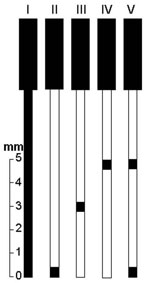New research concludes that the pain relieving effects created by electricity applied to acupuncture needles (electroacupuncture) is dependent  Acupuncture Needleson the subdermal depths at which electricity is emitted from the acupuncture needle. Researchers measured the analgesic effects of five different types of acupuncture needles that were inserted to identical depths. However, each of the five needles had the metal exposed to the skin at different levels along the shaft.
Acupuncture Needleson the subdermal depths at which electricity is emitted from the acupuncture needle. Researchers measured the analgesic effects of five different types of acupuncture needles that were inserted to identical depths. However, each of the five needles had the metal exposed to the skin at different levels along the shaft.
The group 1 needle was completely uncoated and the electricity passed through the entire length of the needle. All of the other needles were coated with an insulated coating and the metal was exposed 0.2mm in length, circumferentially, at varying depths per each type of needle. The group 2 acupuncture needle had the insulated coating peeled off at the tip only. The group 3 acupuncture needle had the insulated coating peeled off at 3mm from the tip. The group 4 acupuncture needle had the insulating material removed at 5mm from the tip, and the group 5 needle had the insulated material removed from the tip and at the 5mm mark. The illustration shows the needle configurations.
The needles were inserted into acuppoints ST36 (Zusanli) and SP9 (Sanyinjiao) on 96 laboratory rats that were divided into the five needle groups. All needles were inserted at a 45 degree angle. The rat tail-flick test was used to determine if analgesia was achieved. Once tabulated, the results showed that the group 1 and group 5 needle groups experienced significantly greater analgesia. Group 1 had the uncoated needle and group 5 had the needle type that was exposed at both the tip and at the 5mm mark. The other three groups had metal exposure at only one area and did not achieve the same level of analgesia. As a result, the researchers conclude that “the efficacy of the EA (electroacupuncture) stimulation depends on the spatial distribution of the current density under the needling surface rather than only the acupoint or the depth of needling.”
Reference:
The antinociceptive effect of electroacupuncture at different depths of acupoints and under the needling surface. Chinese Medicine 2012, 7:3 doi:10.1186/1749-8546-7-3. Silva, Prado, Silva.

